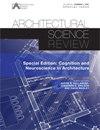Contribution of numerical simulation to the study of pedestrian mobility in the context of COVID-19: case of a university campus in Algeria
IF 1.8
3区 艺术学
0 ARCHITECTURE
引用次数: 1
Abstract
Corona Virus (COVID-19) is forcing us to re-examine our current travel patterns in order to adapt to social distancing. For this purpose, simulation of pedestrian mobility remains relevant and can facilitate the design of buildings and urban spaces in this newly emerging context. Under COVID-19, a university campus in Algeria has been selected to demonstrate digital simulation for the study of pedestrian mobility. Infraworks software founded on multi-agent simulation is used. Based on the establishment and comparison of various scenarios, we are able to confirm the effects of the anti-pandemic measures on pedestrian behavior in the studied area, such as social distance and the decline in student population, and the implementation of new traffic plans to enhance working conditions on the university campus. The results show that this tool enables the readjustment of space and people’s behavior so that the university activities carry on with a minimum health risk.数值模拟对COVID-19背景下行人流动性研究的贡献:以阿尔及利亚一所大学校园为例
冠状病毒(COVID-19)迫使我们重新审视目前的旅行模式,以适应社交距离。为此,模拟行人的流动性仍然是相关的,可以促进建筑和城市空间的设计在这个新兴的背景下。在2019冠状病毒病背景下,阿尔及利亚的一所大学校园被选中进行数字模拟,以研究行人的移动性。采用了基于多智能体仿真的infrworks软件。通过各种场景的建立和比较,我们能够确认抗疫措施对研究区域行人行为的影响,例如社会距离和学生人数的减少,以及实施新的交通计划以改善大学校园的工作条件。结果表明,该工具能够对空间和人的行为进行重新调整,从而使大学活动以最小的健康风险进行。
本文章由计算机程序翻译,如有差异,请以英文原文为准。
求助全文
约1分钟内获得全文
求助全文
来源期刊

Architectural Science Review
ARCHITECTURE-
CiteScore
4.80
自引率
8.70%
发文量
34
期刊介绍:
Founded at the University of Sydney in 1958 by Professor Henry Cowan to promote continued professional development, Architectural Science Review presents a balanced collection of papers on a wide range of topics. From its first issue over 50 years ago the journal documents the profession’s interest in environmental issues, covering topics such as thermal comfort, lighting, and sustainable architecture, contributing to this extensive field of knowledge by seeking papers from a broad geographical area. The journal is supported by an international editorial advisory board of the leading international academics and its reputation has increased globally with individual and institutional subscribers and contributors from around the world. As a result, Architectural Science Review continues to be recognised as not only one of the first, but the leading journal devoted to architectural science, technology and the built environment. Architectural Science Review publishes original research papers, shorter research notes, and abstracts of PhD dissertations and theses in all areas of architectural science including: -building science and technology -environmental sustainability -structures and materials -audio and acoustics -illumination -thermal systems -building physics -building services -building climatology -building economics -ergonomics -history and theory of architectural science -the social sciences of architecture
 求助内容:
求助内容: 应助结果提醒方式:
应助结果提醒方式:


